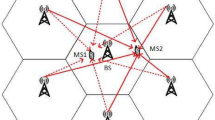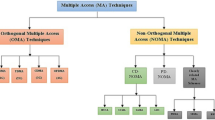Abstract
Both non-orthogonal multiple access (NOMA) and ultra-dense network (UDN) are promising technologies in future wireless networks. However, considering the overlapped coverage of small base stations (SBSs) and the spectrum sharing with NOMA, interference management (IM) becomes a more complex and fundamental problem. Moreover, considering the massive SBSs and dynamic network conditions in UDN, more efficient mechanisms need to be designed to deal with the IM issue. Thus, we propose a distributed self-optimizing interference management approach to address both the intra-cell interference caused by NOMA and the inter-cell interference among dense deployed SBSs. Aiming to minimize the interference and guarantee the users’ requirements, we mathematically formulate the joint resource allocation and user selection problem with consideration of the diverse user requirements, complicated interference topology, and limited resources. Furthermore, we consider the imperfections of successive interference cancellation at receivers for separating and decoding superimposed signals and analyze the impacts of residual interference and outage probability in NOMA-based UDNs. For tractability purpose, we introduce interference graph and satisfaction game theory and propose distributed algorithms to solve the problem. Simulation results show that interference can be reduced significantly in UDNs with NOMA compared with the traditional IM approaches.











Similar content being viewed by others
References
Chen, L., Yu, F. R., Ji, H., Rong, B., Li, X., & Leung, V. C. M. (2016). Green full-duplex self-backhaul and energy harvesting small cell networks with massive MIMO. IEEE Journal on Selected Areas in Communications, 34(12), 3709–3724.
Andrews, J. G., Buzzi, S., Choi, W., Hanly, S. V., Lozano, A., Soong, A. C. K., et al. (2014). What will 5G be? IEEE Journal on Selected Areas in Communications, 32(6), 1065–1082.
Ge, X., Tu, S., Mao, G., Wang, C. X., & Han, T. (2016). 5G ultra-dense cellular networks. IEEE Wireless Communications, 23(1), 72–79.
Islam, S. M. R., Avazov, N., Dobre, O. A., & s. Kwak, K. (2017). Power-domain non-orthogonal multiple access (noma) in 5g systems: Potentials and challenges. IEEE Communications Surveys Tutorials, 19(2), 721–742.
Chen, S., Qin, F., Hu, B., Li, X., & Chen, Z. (2016). User-centric ultra-dense networks for 5G: Challenges, methodologies, and directions. IEEE Wireless Communications, 23(2), 78–85.
Lyu, X., Tian, H., Ni, W., Liu, R. P., & Zhang, P. (2017). Adaptive centralized clustering framework for software-defined ultra-dense wireless networks. IEEE Transactions on Vehicular Technology, 66(9), 8553–8557.
Gu, Y., Cui, Q., Chen, Y., Ni, W., Tao, X., & Zhang, P. (2018). Effective capacity analysis in ultra-dense wireless networks with random interference. IEEE Access, 6, 19499–19508.
Kim, J., & Cho, D. H. (2010). A joint power and subchannel allocation scheme maximizing system capacity in indoor dense mobile communication systems. IEEE Transactions on Vehicular Technology, 59(9), 4340–4353.
Yang, C., Li, J., Semasinghe, P., Hossain, E., Perlaza, S. M., & Han, Z. (2017). Distributed interference and energy-aware power control for ultra-dense d2d networks: A mean field game. IEEE Transactions on Wireless Communications, 16(2), 1205–1217.
Xiao, J., Yang, C., Wang, J., & Dai, H. (2016). Joint interference management in ultra-dense small cell networks: A multi-dimensional coordination. In Proceedings of WCSP’16, Yangzhou, China.
Mahmood, N. H., Berardinelli, G., Pedersen, K. I., & Mogensen, P. (2015). An interference-aware distributed transmission technique for dense small cell networks. In Proceedings of IEEE ICC WKSHPS’15, London, UK.
Abdelnasser, A., & Hossain, E. (2013). Subchannel and power allocation schemes for clustered femtocells in two-tier OFDMA hetnets. In Proceedings of IEEE ICC WKSHPS’13, Budapest, Hungary.
Xiao, J., Yang, C., Anpalagan, A., Ni, Q., & Guizani, M. (2018). Joint interference management in ultra-dense small cell networks: A multi-domain coordination perspective. IEEE Transactions on Communications, 66, 5470–5481.
Yang, C., Dai, H., Li, J., Zhang, Y., & Han, Z. (2018). Distributed interference-aware power control in ultra-dense small cell networks: A robust mean field game. IEEE Access, 6, 12608–12619.
Liu, Y., Li, X., Yu, F. R., Ji, H., Zhang, H., & Leung, V. C. M. (2017). Grouping and cooperating among access points in user-centric ultra-dense networks with non-orthogonal multiple access. IEEE Journal on Selected Areas in Communications, 35(10), 2295–2311.
Zhang, Z., Yang, G., Ma, Z., Xiao, M., Ding, Z., & Fan, P. (2018). Heterogeneous ultradense networks with noma: System architecture, coordination framework, and performance evaluation. IEEE Vehicular Technology Magazine, 13(2), 110–120.
Fang, F., Zhang, H., Cheng, J., & Leung, V. C. M. (2016). Energy-efficient resource allocation for downlink non-orthogonal multiple access network. IEEE Transactions on Communications, 64(9), 3722–3732.
Ali, M. S., Tabassum, H., & Hossain, E. (2016). Dynamic user clustering and power allocation for uplink and downlink non-orthogonal multiple access (NOMA) systems. IEEE Access, 4, 6325–6343.
Wang, X., Zhang, H., Tian, Y., Ding, Z., & Leung, V. C. M. (2018). Locally cooperative interference mitigation for small cell networks with non-orthogonal multiple access: A potential game approach. In Proceedings of IEEE ICC’18 (pp. 1–6).
Ali, K. S., Elsawy, H., Chaaban, A., & Alouini, M. S. (2017). Non-orthogonal multiple access for large-scale 5G networks: Interference aware design. IEEE Access, 5, 21204–21216.
Chen, Z., Ding, Z., & Dai, X. (2016). Beamforming for combating inter-cluster and intra-cluster interference in hybrid noma systems. IEEE Access, 4, 4452–4463.
Zhang, Z., Sun, H., & Hu, R. Q. (2017). Downlink and uplink non-orthogonal multiple access in a dense wireless network. IEEE Journal on Selected Areas in Communications, 35(12), 2771–2784.
Wang, X., Zhang, H., Tian, Y., Zhu, C., & Leung, V. C. M. (2018). Optimal distributed interference mitigation for small cell networks with non-orthogonal multiple access: A locally cooperative game. IEEE Access, 6, 63107–63119.
Deb, S., & Monogioudis, P. (2015). Learning-based uplink interference management in 4G LTE cellular systems. IEEE/ACM Transactions on Networking, 23(2), 398–411.
López-Pérez, D., Ladanyi, A., Jüttner, A., & Zhang, J. (2009). OFDMA femtocells: A self-organizing approach for frequency assignment. In Proceedings of IEEE PIMRC’09, Tokyo, Japan.
Gelabert, X., Sayrac, B., & Jemaa, S. B. (2014). A heuristic coordination framework for self-optimizing mechanisms in LTE hetnets. IEEE Transactions on Vehicular Technology, 63(3), 1320–1334.
Zhang, H., Wang, Y., & Ji, H. (2016). Resource optimization-based interference management for hybrid self-organized small-cell network. IEEE Transactions on Vehicular Technology, 65(2), 936–946.
Adedoyin, M., & Falowo, O. (2016). Self-organizing radio resource management for next generation heterogeneous wireless networks. In Proceedings of IEEE ICC’16, Kuala Lumpur, Malaysia.
Shin, W., Vaezi, M., Lee, B., Love, D. J., Lee, J., & Poor, H. V. (2017). Non-orthogonal multiple access in multi-cell networks: Theory, performance, and practical challenges. IEEE Communications Magazine, 55(10), 176–183.
You, L., Lei, L., Yuan, D., Sun, S., Chatzinotas, S., & Ottersten, B. (2017). A framework for optimizing multi-cell noma: Delivering demand with less resource. In Proceedings of IEEE GLOBECOM’17 (pp. 1–7).
Luo, C., Yu, F. R., Ji, H., & Leung, V. C. M. (2010). Cross-layer design for TCP performance improvement in cognitive radio networks. IEEE Transactions on Vehicular Technology, 59(5), 2485–2495.
Ali, K. S., Elsawy, H., Chaaban, A., & Alouini, M. (2017). Non-orthogonal multiple access for large-scale 5g networks: Interference aware design. IEEE Access, 5, 21204–21216.
Chen, D. C., Quek, T. Q. S., & Kountouris, M. (2015). Backhauling in heterogeneous cellular networks: Modeling and tradeoffs. IEEE Transactions on Wireless Communications, 14(6), 3194–3206.
Liu, Y., Ding, Z., Elkashlan, M., & Poor, H. V. (2016). Cooperative non-orthogonal multiple access with simultaneous wireless information and power transfer. IEEE Journal on Selected Areas in Communications, 34(4), 938–953.
Sheng, M., Xu, C., Wang, X., Zhang, Y., Han, W., & Li, J. (2014). Utility-based resource allocation for multi-channel decentralized networks. IEEE Transactions on Communications, 62(10), 3610–3620.
Li, G., & Liu, H. (2006). Downlink radio resource allocation for multi-cell OFDMA system. IEEE Transactions on Wireless Communications, 5(12), 3451–3459.
Bondy, J. A., Murty, U. S. R., et al. (1976). Graph theory with applications (Vol. 290). Citeseer.
Perlaza, S. M., Tembine, H., Lasaulce, S., & Debbah, M. (2012). Quality-of-service provisioning in decentralized networks: A satisfaction equilibrium approach. IEEE Journal of Selected Topics in Signal Processing, 6(2), 104–116.
ETSI, L. Evolved universal terrestrial radio access (e-utra); physical channels and modulation. ETSI TS 136(211), V9
Acknowledgements
This work is supported by the National Natural Science Foundation of China (Grant No. 61771070 and Grant No. 61671088) and the Canadian Natural Sciences and Engineering Research Council (Grant No. RGPIN-2019-06348).
Author information
Authors and Affiliations
Corresponding author
Additional information
Publisher's Note
Springer Nature remains neutral with regard to jurisdictional claims in published maps and institutional affiliations.
Rights and permissions
About this article
Cite this article
Liu, Y., Yu, F.R., Li, X. et al. Distributed self-optimizing interference management in ultra-dense networks with non-orthogonal multiple access. Wireless Netw 26, 2809–2823 (2020). https://doi.org/10.1007/s11276-019-02215-z
Published:
Issue Date:
DOI: https://doi.org/10.1007/s11276-019-02215-z




